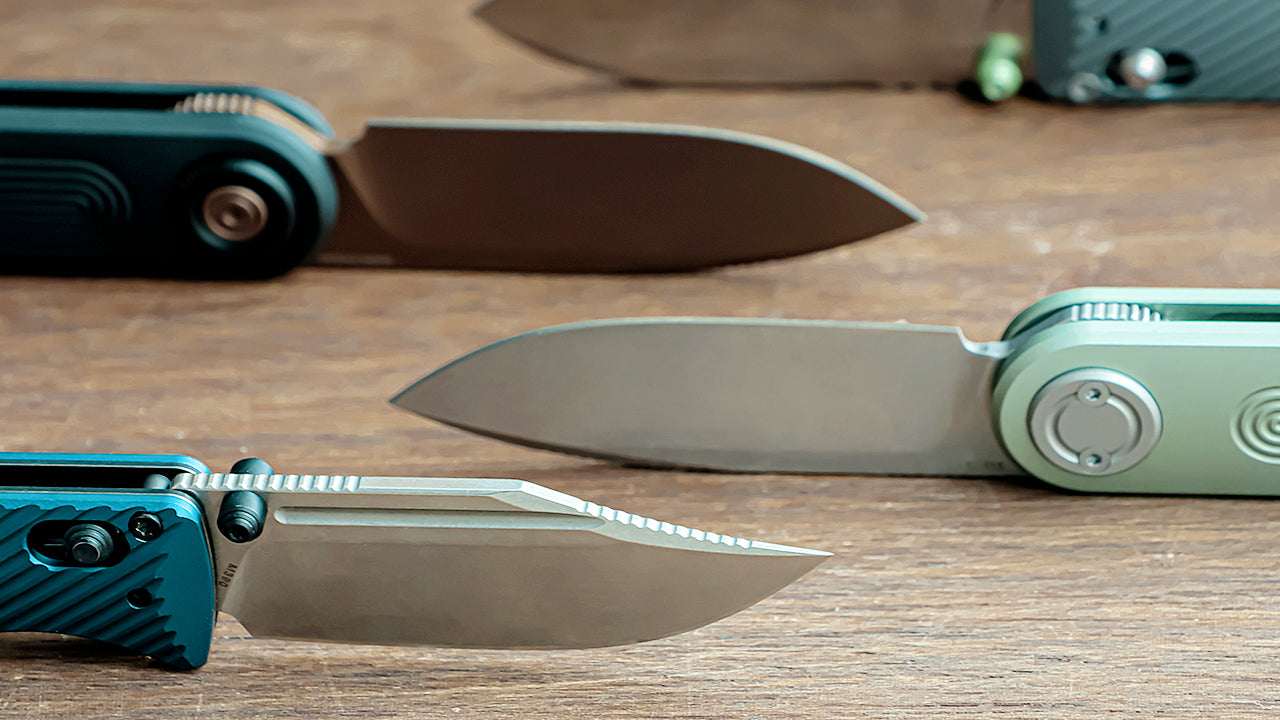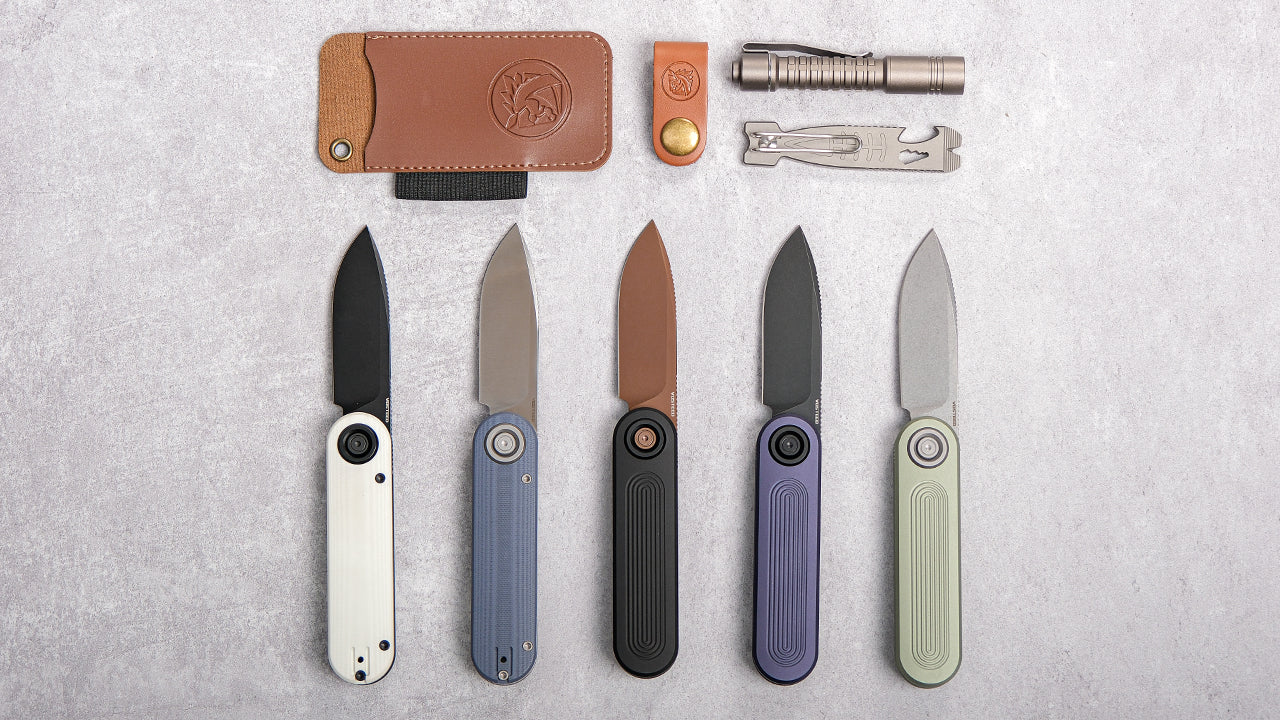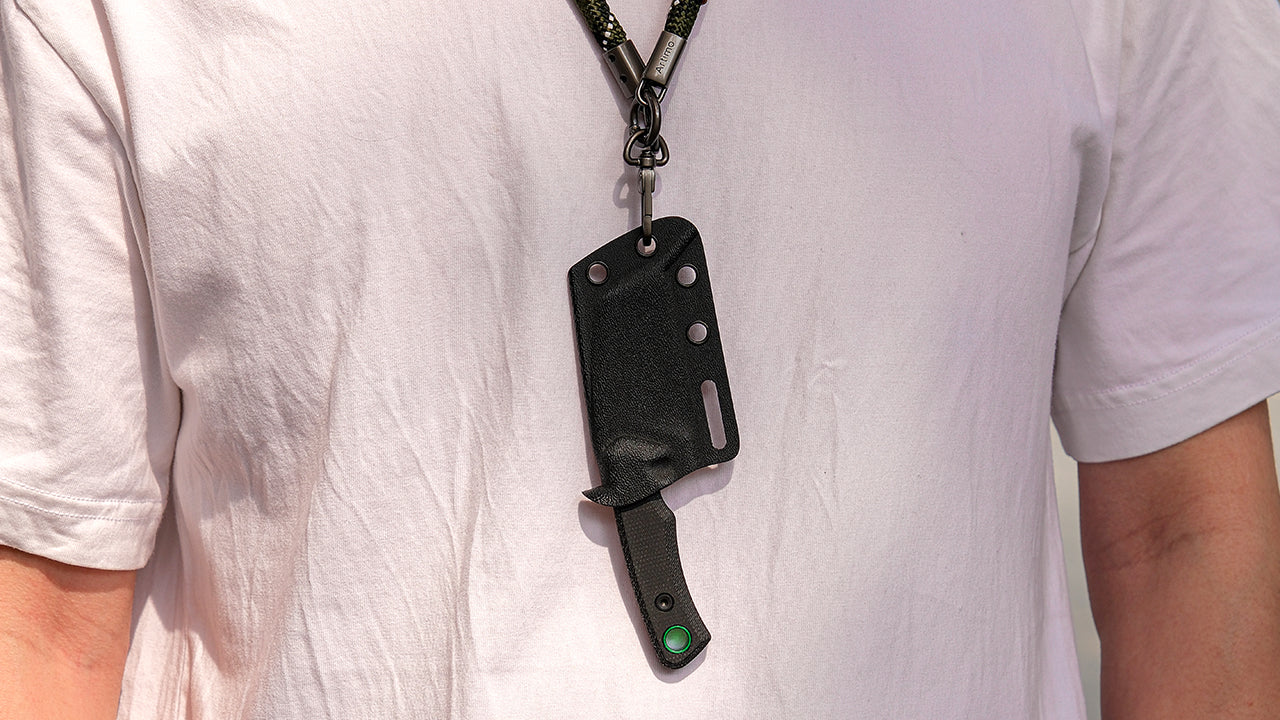When it comes to choosing the best pocket knife steels, the material you select is crucial to the performance and longevity of the blade. The "cutting edge" of technology is evident in how knife steels have evolved, with each advancement pushing the limits of sharpness, durability, and corrosion resistance — after all, the material of the blade is the heart of the knife.

What Makes a Great Pocket Knife Blade?
The sharpness of a knife’s edge can be measured through four closely intertwined dimensions, each playing a vital role in its overall performance: Hardness, toughness, corrosion resistance and ease of sharpening. The right steel ensures your knife holds its edge longer, resists corrosion, and stays durable through tough use. These qualities are particularly important when you’re relying on your knife day in and day out:
- Hardness (Edge Retention): Affects edge retention but can make the steel more brittle.
- Toughness (Resistance to Chipping/Breaking): Determines resistance to chipping and breaking, but may reduce edge retention.
- Corrosion Resistance: Stainless steels are resistant to rust due to their chromium content.
- Ease of Sharpening: Generally, harder steels are harder to sharpen, though the time and effort required are subjective.
To conclude their relation in one graph:

Understanding Blade Steel Performance
After identifying the key factors behind blade performance, real-world examples reveal just how crucial these traits are—and which materials stand out most in each category:
Edge Retention: How Long Will Your Knife Stay Sharp?
Edge retention is the secret behind a knife’s lasting sharpness and enduring performance, ensuring it stays as reliable and efficient as the day you first used it. Some steels, like Vanax, M390 and Elmax, excel at holding their sharpness over time, meaning you don’t need to worry about sharpening your knife frequently. This is especially important for those who use their knives for precision tasks or in harsh environments.
Toughness: Can Your Blade Handle Hard Use?
Toughness is a steel's ability to withstand rough use without cracking or chipping. D2 Steel and S35VN are both known for their excellent toughness, making them suitable for outdoor tasks like batoning or chopping, where blades can experience heavy impacts.
Corrosion Resistance: Will Your Knife Rust?
Corrosion resistance is key if you're using your knife near water or in moist conditions. M390 and Elmax steels are excellent in this regard, offering exceptional resistance to rust. If you're looking for a knife that will survive in wet or salty environments, these steels are ideal choices.
Ease of Sharpening: How Hard Is It to Maintain Your Edge?
While steels like D2 offer great edge retention and toughness, they can be challenging to sharpen. On the other hand, steels like 154CM and 14C28N are easier to sharpen, making them ideal for users who prefer a more user-friendly sharpening experience.

Popular Types of Pocket Knife Steels
So when it comes to what you care about most—the types of blades—what are your options?
Vanax Knife: The Ultimate Corrosion Fighter
Vanax SuperClean represents the pinnacle of nitrogen-based steel technology, containing 1.55% nitrogen instead of relying heavily on carbon like traditional steels. This revolutionary approach creates ultra-fine nitride particles that deliver exceptional corrosion resistance - even superior to many marine-grade steels. With 18.2% chromium and advanced powder metallurgy processing, Vanax offers outstanding edge retention while remaining surprisingly easy to sharpen due to its fine microstructure.
Elmax Steel Knives: Toughness Meets Stainless
Elmax knives are crafted from a powder metallurgy steel (~1.7% carbon, 18% Cr) with vanadium and molybdenum. Its uniform microstructure yields excellent toughness and corrosion resistance, while maintaining edge stability under heavy load.
M390 Knife & M390 Folding Knife: Premium Edge Retention and Corrosion Resistance
M390, from Böhler-Uddeholm, contains 1.9% carbon, 20% chromium, and 4% vanadium. Its high vanadium carbide content gives excellent wear resistance. High chromium ensures strong rust resistance but makes sharpening more difficult.
S35VN Knife: The Balanced EDC Choice
S35VN is a CPM stainless steel with ~1.4% carbon, 14% chromium, plus vanadium and niobium. Niobium refines grain structure, enhancing wear resistance and toughness. Fine carbides support good corrosion resistance and relatively easy sharpening.
154CM Steel Knives: Classic Mid-Range Steel
154CM has 1.05% carbon, 14% chromium, and 4% molybdenum. Though not a powder steel, it delivers reliable corrosion resistance and edge retention with good hardness. Easy to maintain compared to super steels.
Nitro V Knives: Modern Stainless for EDC
Nitro V improves AEB-L with added nitrogen and trace vanadium. Around 0.68% carbon and 14.5% chromium support fine edge geometry, excellent corrosion resistance, and toughness. If you're looking for blades that hold up under regular use and resist rust, Nitro V knives are a top choice.
14C28N Knives: Best Budget Stainless
If you’re looking for high-performance steel on a budget, 14C28N has ~0.62% carbon and nitrogen-enriched stainless content. It provides good corrosion resistance and ease of sharpening, making it a great choice for beginners or those looking for a reliable, affordable option.
D2 Steel Knife: Affordable Performance
D2 is a high-carbon tool steel (~1.5% C, ~11% Cr) with large primary carbides. It’s not stainless, so some care is needed—but for heavy use where performance matters more than looks, D2 is a solid, budget-friendly choice.
Damascus Knife, Damascus Pocket Knife, Damascus Folding Knife: Performance and Aesthetics
While Damascus steel is often chosen for its beautiful, layered patterns, it also offers excellent performance in terms of edge retention and toughness. They are perfect for those who appreciate both aesthetics and functionality.

Comparing the Best EDC Blades: Performance Table
The chart below provides a more intuitive look at the pros and cons of each material:
| Blade Steel | Edge Retention | Toughness | Corrosion Resistance | Ease of Sharpening |
| Vanax | ★★★★★ | ★★★★☆ | ★★★★★ | ★★★★☆ |
| Elmax | ★★★★★ | ★★★★★ | ★★★★★ | ★★☆☆☆ |
| M390 | ★★★★★ | ★★★★☆ | ★★★★★ | ★★☆☆☆ |
| S35VN | ★★★★☆ | ★★★★★ | ★★★★☆ | ★★★☆☆ |
| 154CM | ★★★★☆ | ★★★☆☆ | ★★★★☆ | ★★★★★ |
| Nitro V | ★★★★☆ | ★★★☆☆ | ★★★★★ | ★★★★★ |
| 14C28N | ★★★★☆ | ★★★☆☆ | ★★★★☆ | ★★★★★ |
| D2 | ★★★★☆ | ★★★★★ | ★★☆☆☆ | ★★★☆☆ |
| Damascus | - | - | - | - |
*Damascus steel is made by layering different types of steel, creating unique patterns on the surface. The types and proportions of steel used are not fixed, and the combination of materials and methods may vary depending on the process and the maker's needs.
Looking at the performance comparison chart above, Vanax clearly stands out as the top-tier steel—with virtually no weak spots across the board. But what about the price? Well, you can’t expect perfection to come cheap… unless you're willing to weigh all the factors and choose the steel that offers the best balance of performance and value:

Best Value for Money: Nitro V
Nitro V delivers strong all-around performance across the board, with standout corrosion resistance and sharpening ease, all at a much lower price than top-tier steels. It's a top pick for practical users looking for performance without the premium cost.
-
Runner-Up: 14C28N
- Pros: Easy to sharpen, great corrosion resistance, cheapest on the list (~2.0).
- Cons: Slightly lower toughness and edge retention.
- Best For: Kitchen knives and small EDC blades.
-
Premium, but Expensive: M390 / Elmax
Excellent performance, but the high cost lowers their value for budget-conscious users.
-
Ultra-Premium: Vanax
- Pros: Ultimate corrosion resistance, nitrogen-based technology, easy to sharpen despite hardness.
- Cons: Highest cost among all steels (~5.5), limited availability.
- Best For: Marine environments, high-end collectibles, demanding wet conditions.
Best Blade Types for Everyday Carry, Outdoor, and Tactical Use
What if we looked at it from the perspective of use cases?
- EDC: Opt for Nitro V, S35VN, or 14C28N — all offer excellent corrosion resistance, easy sharpening, and hassle-free maintenance for everyday use.
- Outdoor: Choose Vanax, Elmax, or D2 — Vanax excels in wet/marine conditions with unmatched corrosion resistance, while Elmax and D2 offer excellent toughness for heavy-duty tasks.
- Tactical: Go with Vanax, M390, or S35VN — premium choices that deliver top-notch edge retention, toughness, and corrosion resistance under high-stress conditions.
How to Choose the Right Pocket Knife Steel
Now that we’ve explored the different materials, how do we go about making the right choice?
Step 1: Match Steel to Your Use
When choosing your knife steel, think about how you’ll use it:
EDC (Everyday Carry) – Look for a balance of durability and edge retention
→ S35VN or Nitro V are great choices
Outdoor Use – Choose steels that can handle heavy-duty tasks
→ D2 or Elmax offer excellent toughness
Collection – Go for beauty and performance
→ Damascus steel stands out visually and functionally
Step 2: Consider Budget, Maintenance, and Sharpening Tools
On a Budget / Low Maintenance
→ 14C28N or Nitro V perform well and don’t require expensive sharpening gear
High Performance / Don’t Mind Extra Care
→ M390 or Vanax deliver top-tier results but need more upkeep
Other Factors That Impact Knife Performance
- Blade Geometry: The shape and thickness of the blade affect cutting performance and strength.
- Handle Material: The comfort and grip of the handle impact how the knife feels during use.
- Locking Mechanism: For folding knives, the locking mechanism ensures safety during use.
Frequently Asked Questions about Pocket Knife Steels
Q1: How does Nitro V compare to other popular steels like S35VN or M390?
Nitro V is highly corrosion-resistant and easy to sharpen, with good toughness and edge retention. S35VN holds an edge longer and is tougher, but is harder to sharpen and more expensive. M390 offers the best edge retention and wear resistance, but is less tough and much harder to sharpen than Nitro V.
Q2: What’s the best way to maintain a Nitro V blade?
Clean and dry the blade after use, especially if it gets wet or dirty. Occasionally apply a light coat of oil for extra protection. Nitro V is easy to sharpen with standard tools, making routine touch-ups simple—even for beginners.
Q3: S35VN vs. M390: Which Is Better for EDC?
M390 offers outstanding edge retention but can be more difficult to sharpen. S35VN, on the other hand, strikes a better balance between performance and ease of sharpening, making it a solid choice for everyday carry.
Q4: Is Damascus Steel Worth It for Pocket Knives?
Yes, Damascus steel is not only visually stunning but also offers great edge retention and toughness. That said, it may require a bit more care than stainless steels like M390 or Nitro V.
Q5: What Makes Vanax Stand Out?
Vanax combines nitrogen-based metallurgy with exceptional corrosion resistance that surpasses even marine-grade steels. Its unique composition creates ultra-fine nitrides rather than carbides, resulting in superior rust resistance while maintaining excellent edge retention and surprisingly easy sharpening characteristics.
Q6: Are 14C28N Knives Good for Beginners?
Yes! 14C28N is a fantastic option for beginners thanks to its budget-friendly price, good corrosion resistance, and ease of sharpening. It’s a practical, no-fuss steel that performs well in everyday use.
Selecting the Best Pocket Knife Steel for You
There’s no one perfect steel for everyone—it all depends on how you plan to use your knife, what features matter most, and how much you’re willing to spend. Whether you prioritize edge retention, corrosion resistance, ease of sharpening, or simply the best value for your budget, there’s a steel that fits your needs.
Take your time, consider your use cases and price point, and enjoy the process of finding the blade that feels just right for you.





Leave a comment
All comments are moderated before being published.
This site is protected by hCaptcha and the hCaptcha Privacy Policy and Terms of Service apply.